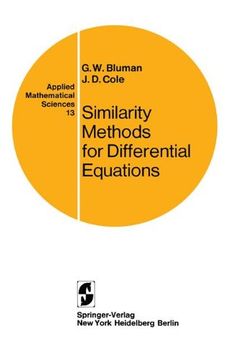Share
Similarity Methods for Differential Equations
George W. Bluman; G. W. Bluman; J. D. Cole (Author)
·
Springer
· Paperback
Similarity Methods for Differential Equations - George W. Bluman; G. W. Bluman; J. D. Cole
Choose the list to add your product or create one New List
✓ Product added successfully to the Wishlist.
Go to My Wishlists
Origin: U.S.A.
(Import costs included in the price)
It will be shipped from our warehouse between
Friday, May 31 and
Tuesday, June 18.
You will receive it anywhere in United Kingdom between 1 and 3 business days after shipment.
Synopsis "Similarity Methods for Differential Equations"
The aim of this book is to provide a systematic and practical account of methods of integration of ordinary and partial differential equations based on invariance under continuous (Lie) groups of trans formations. The goal of these methods is the expression of a solution in terms of quadrature in the case of ordinary differential equations of first order and a reduction in order for higher order equations. For partial differential equations at least a reduction in the number of independent variables is sought and in favorable cases a reduction to ordinary differential equations with special solutions or quadrature. In the last century, approximately one hundred years ago, Sophus Lie tried to construct a general integration theory, in the above sense, for ordinary differential equations. Following Abel's approach for algebraic equations he studied the invariance of ordinary differential equations under transformations. In particular, Lie introduced the study of continuous groups of transformations of ordinary differential equations, based on the infinitesimal properties of the group. In a sense the theory was completely successful. It was shown how for a first-order differential equation the knowledge of a group leads immediately to quadrature, and for a higher order equation (or system) to a reduction in order. In another sense this theory is somewhat disappointing in that for a first-order differ ential equation essentially no systematic way can be given for finding the groups or showing that they do not exist for a first-order differential equation.
- 0% (0)
- 0% (0)
- 0% (0)
- 0% (0)
- 0% (0)
All books in our catalog are Original.
The book is written in English.
The binding of this edition is Paperback.
✓ Producto agregado correctamente al carro, Ir a Pagar.

